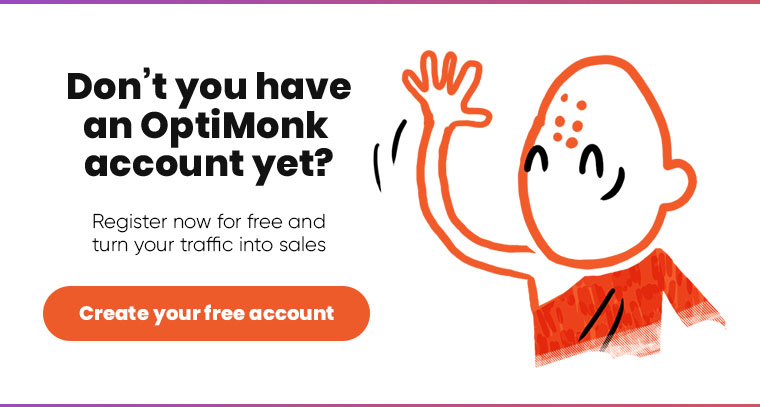- Blog
- Best Ecommerce Personalization Stats, Types, Examples & Tools
Best Ecommerce Personalization Stats, Types, Examples & Tools
-
Nikolett Lorincz
- Personalization
- 6 min read
Table of Contents
Over the past few years, it’s become increasingly clear that delivering a personalized shopping experience is the key to customer engagement and higher sales. In fact, 94% of businesses say that ecommerce personalization is critical to their present and future success.
However, it’s such a new force that online retailers still aren’t sure how to create a winning ecommerce personalization strategy.
In this article, we’ll share the most important ecommerce personalization trends and statistics, some great personalized campaigns you can set up today, the best ecommerce personalization software available right now, and more.
We’ve got a lot to cover, so let’s get started!
7 revealing stats about ecommerce personalization
Let’s look at some interesting statistics that establish why having a great ecommerce personalization strategy is so important in 2025:
- 91% of consumers say that they’re more likely to shop with brands that remember their preferences and use them to provide relevant offers and recommendations.
- 74% of Gen Zers show an interest in personalized products (vs. 67% of Millennials, 61% of Gen Xers, and 57% of Baby Boomers).
- 83% of consumers are willing to share their data to “receive the benefits of a personalized experience.”
- 52% of consumers want personalized offers based on data from their customer loyalty accounts.
- Personalized messages in email marketing campaigns generate 5-15% more revenue than those without any personalization.
- 65% of ecommerce stores report an increase in conversion rates after adopting a personalization strategy.
- 74% of marketers claim that ecommerce personalization has a “strong” or “extreme” impact on online retailers.
As these numbers clearly demonstrate, both consumers and marketers recognize the importance of ecommerce personalization.
Customers understand that when an ecommerce website delivers personalized content to them, they benefit from better product recommendations, unique offers, and an improved customer experience.
On the other hand, marketers have learned that ecommerce personalization leads to shorter customer journeys for new customers, as well as more repeat purchases and loyal customers.
A personalized shopping experience starts with collecting customer data
To display the most relevant content possible, you’ll first have to design a data collection strategy.
Gathering customer data is fundamental for driving personalized experiences in ecommerce, enabling brands to understand customer behavior, tailor marketing strategies, and enhance engagement throughout the customer journey.
As soon as first-time visitors hit your landing pages, you should start to gather customer data about everything from their geographic location to their behavior.
Then, you can begin to display personalized content and product recommendations both during that first visit and in the future.
Check out this video to learn what kind of data you need for website personalization:
There are two main ways of collecting data:
- Explicit data collection
- Implicit data collection
It’s important to note that these aren’t mutually exclusive, meaning that you can do both at the same time.
Let’s take a closer look at each of these methods of collecting data.
1. Explicit data collection
Sometimes referred to as “zero-party data,” explicitly collected data comes from asking your customers for their information directly.
For example, when customers create an account and enter their name, email, and shipping information, they’re providing zero-party data.
You can also collect data about your users’ interests and preferences, which is particularly useful for creating customer segments.
Here are some common approaches to collecting explicit data:
- Asking customers to rate items on sliding scales
- Encouraging customers to search for products
- Allowing customers to “favorite” or “like” products
- Asking customers to specify their gender, location, and other objective data
- Asking customers to rank a set of items
Another way of collecting explicit data that’s become popular lately is called a quiz funnel.
The idea is that you offer new customers the chance to take a quiz, which will reveal valuable information or insights.
Brands like Sephora, Warby Parker, and Rare Beauty have all started using quiz funnels to help them segment visitors based on the answers they give on the quiz.
Quiz funnels are interactive, conversational, and fun, which is why they’re so effective.
Here’s a great example from Sephora, whose quiz promises to reveal the hair-care solutions that customers are looking for.
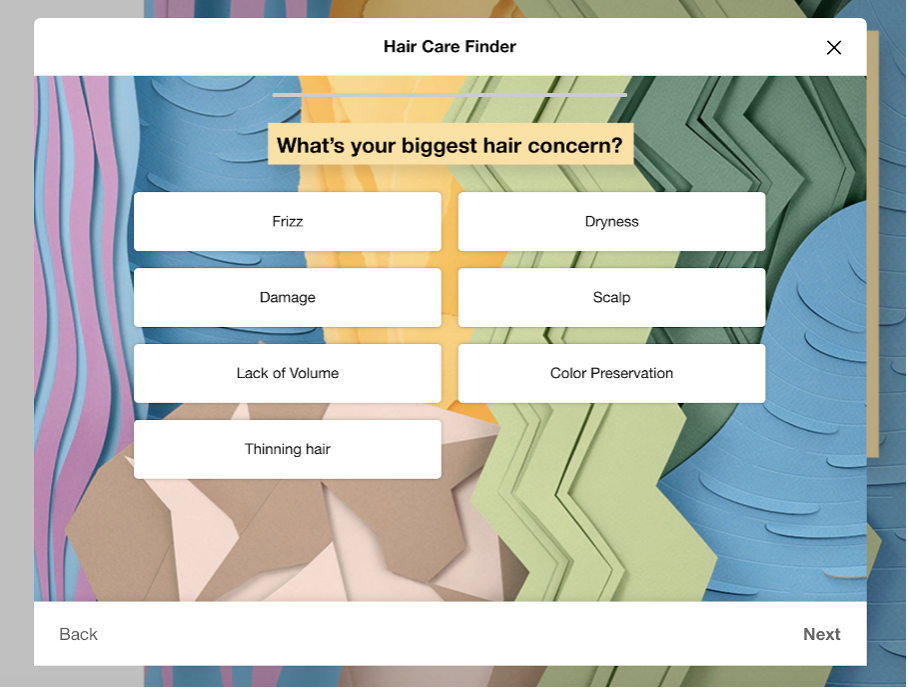
Once you learn what problem a site visitor is trying to solve, you can display products that are tailored to that specific need. This helps customers quickly and easily find the products they’re interested in.
You can create a similar popup for your ecommerce site using one of OptiMonk’s Conversational Popup templates:
2. Implicit data collection
Implicit data collection occurs when the browsing behavior of a user is tracked and used to deliver more personalized customer experiences.
When the data is collected based on actions that occur on your own site, this information is called “first-party data.” In contrast, it’s referred to as “third-party data” when it’s collected by other companies on different websites.
You can modify the content you show to each of your customers based on implicitly collected data. For example, you could use ecommerce personalization to recommend items whose product pages customers have viewed on previous visits.
Here are some common ways of collecting implicit customer data:
- Tracking the product pages and category pages that customers view
- Analyzing how long customers view product and category pages
- Keeping a record of customers’ previous purchases
- Analyzing customers’ language and word choice in both organic search and on-site search
- Analyzing customers’ behavior and engagement on social networks
- Observing customers’ geo-location based on IP addresses
- Observing whether customers are visiting a site on desktops or mobile devices
All of this information can help you achieve better ecommerce personalization.
But to leverage these insights, you’re going to need ecommerce personalization software that’s capable of analyzing the behavior of your customer base and personalizing each customer’s experience.
OptiMonk’s advanced targeting settings allow you to use implicit data to show personalized campaigns to highly specific customer segments.
For example, you can show one popup campaign to first-time visitors and another to returning visitors, but you can also customize your campaigns even further using different factors like the source of traffic, geo-location, and browsing history.
Here’s an example of a popup that uses dynamic content to specify which region their free shipping offer applies to. The country listed depends on the geo-location of the customer that views the campaign.
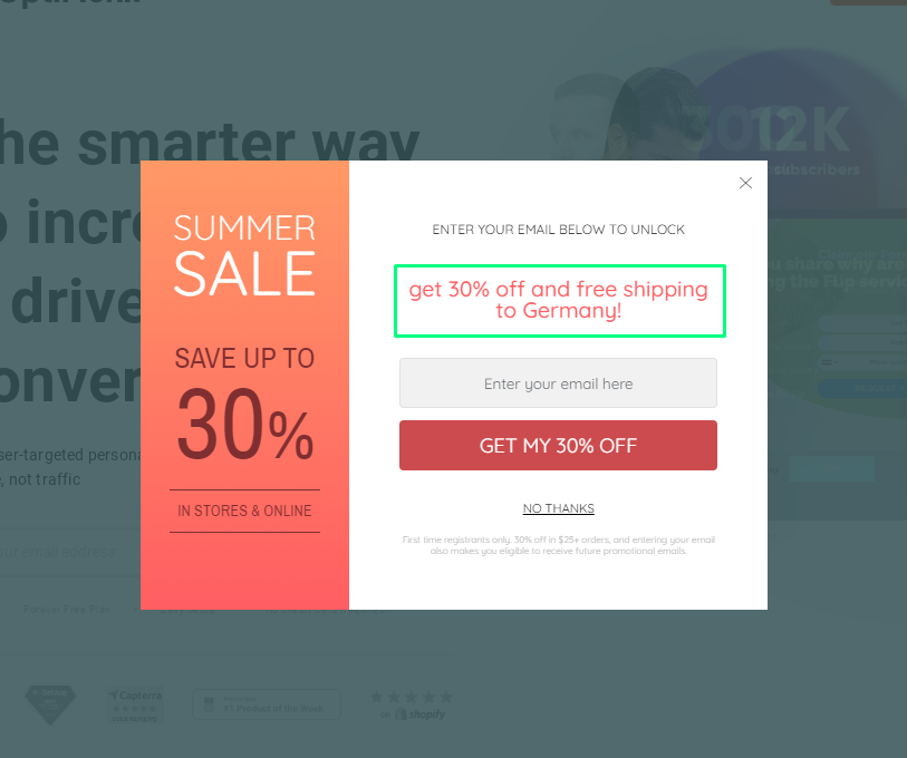
2 approaches to personalization
Now that we’ve gone over how to collect the data you need for ecommerce personalization, let’s look at the two main approaches to personalization.
Once again, these two approaches can (and should!) be used together by the same online store.
1. Prescriptive ecommerce personalization
This first type of ecommerce personalization occurs when you specify the rules that determine what content should be presented to different visitor segments.
It’s also called the “rule-based” method: you’ll need to create rules like “IF customer A is interested in face creams, THEN display products in that category to customer A.”
These rules can use whatever type of customer data you’re collecting (like browsing history, revealed preferences, and on-site behavior) as the trigger for a rule.
You can also create more complex ecommerce personalization rules by using more conditions for triggering more specific rules.
For instance, “IF customer B is interested in face creams AND located in the United States, THEN offer a free shipping coupon for items in that category.” This rule creates a more personalized shopping experience because it addresses an even smaller customer segment than the previous rule.
Using OptiMonk’s advanced targeting settings, you can create incredibly specific rules to create campaigns that display personalized content.
Below is an example of a targeting rule for an OptiMonk campaign that will appear to users who are:
- new visitors,
- from the United States, and
- have visited the face creams category page
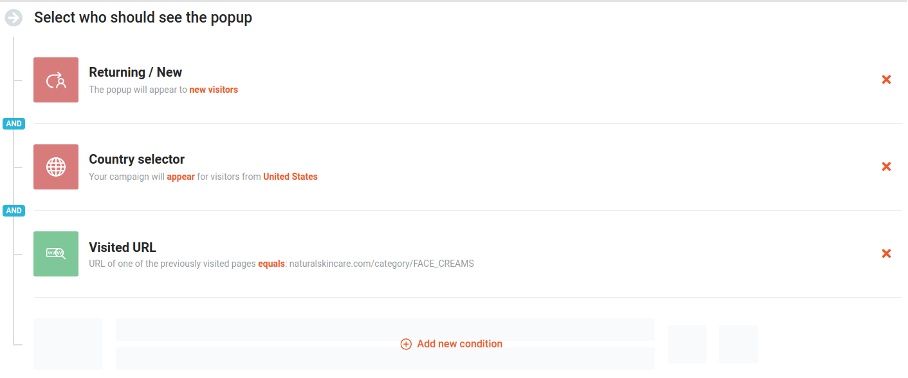
You can stack as many of these rules as you like, creating increasingly specific targeted campaigns. You can also create custom rules based on whatever types of data you’ve managed to collect.
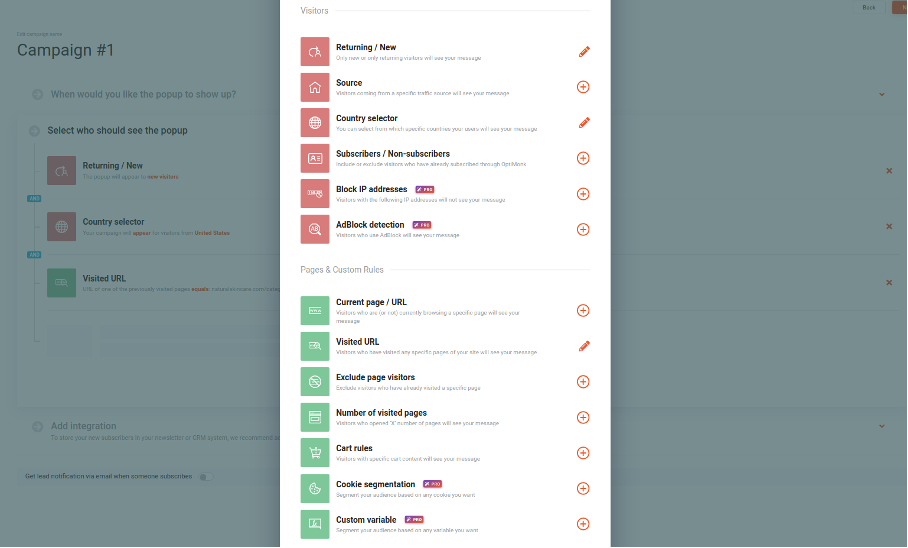
Although prescriptive ecommerce personalization takes a bit of work to set up, it works quite well because the people creating the rules have an excellent (human) understanding of the customer journey that site visitors go through.
In contrast, the next type of personalization we’ll look at uses less human input and offers greater automation.
2. Adaptive ecommerce personalization
Unlike prescriptive personalization, adaptive ecommerce personalization is an automated process that continually applies an evolving self-managed set of rules.
In other words, it modifies its own rules continuously, and the best (or most relevant) rule will be used for each visitor automatically.
Some ecommerce personalization platforms use machine learning to continually improve their performance.
To use this type of personalization, you’ll need access to serious ecommerce personalization software. That’s because by definition, adaptive personalization modifies the customer experience without human input.
There’s a list of the best ecommerce personalization software at the end of this article, but for now, let’s look at just one capability from Limespot Personalizer that uses adaptive personalization.
Limespot Personalizer’s “Intelligent Product Recommendations” feature builds and tests different combinations of products to present to customers.
Based on your goals (e.g. whether you’re more interested in increasing conversions or in cross-selling to increase your average order value), the ecommerce personalization software will create and test new versions of its recommendations, quickly learning which combinations of products work best for each type of visitor.
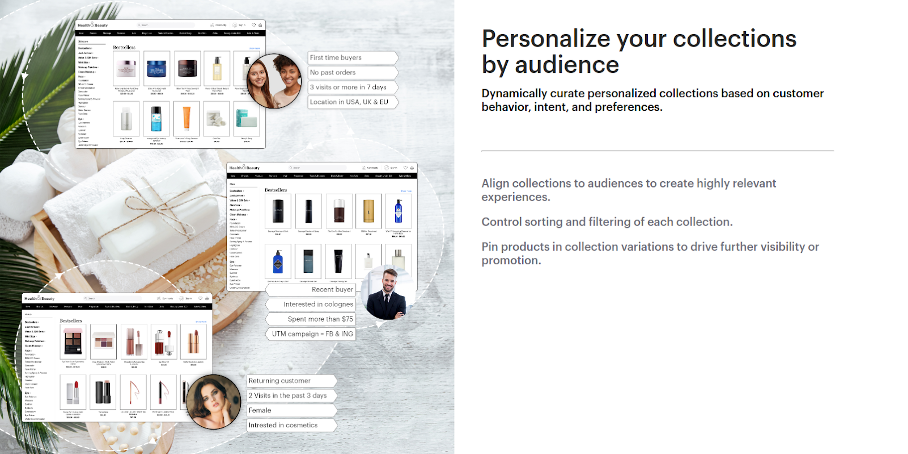
7 ecommerce personalization examples to improve the customer journey
Now that we’ve discussed the theory behind ecommerce personalization, let’s check out how it works in practice.
The following personalization examples from top ecommerce stores represent just a few ways to create an individualized buyer journey for each visitor. They show how to deliver personalized content by tailoring user experiences based on individual preferences and behaviors.
1. Personalization based on the product customers are looking at
Kiss My Keto uses this exit popup with personalized content to mention the specific product that users were looking for before trying to leave the website.
Since they already have a good idea of what a user is interested in, they can make their discount offer much more specific and enticing than a general “15% off” coupon.
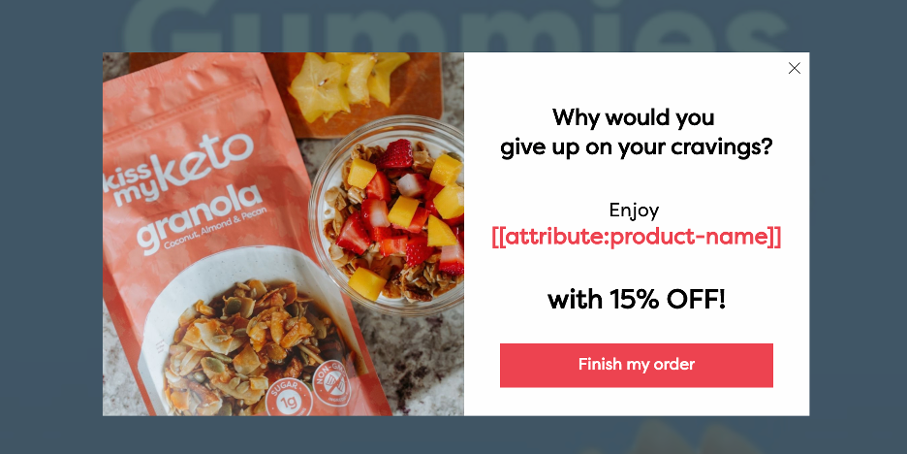
2. Personalization based on the category customers are viewing
You can also provide personalized customer experiences by tailoring content based on the product categories that users have been browsing. This data can be used to provide individually tailored recommendations.
Here’s what this could look like in an exit-intent popup:
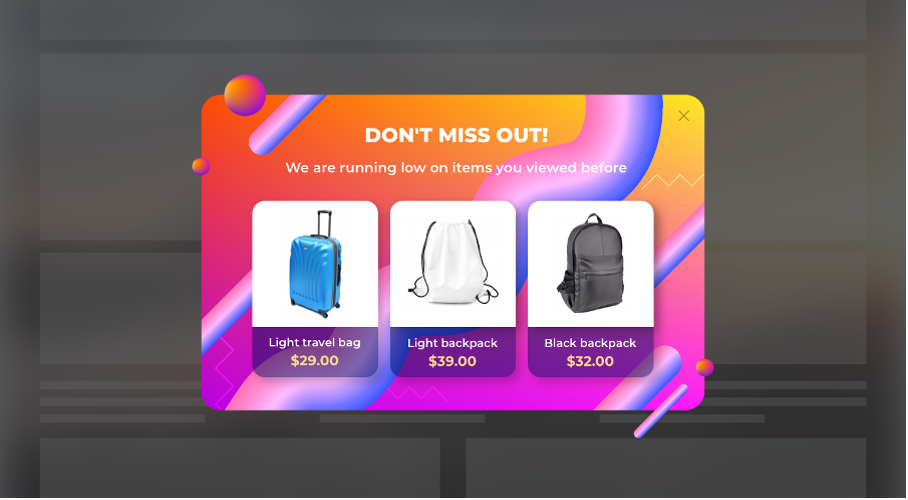
Notice how a single message, “We are running low on items you viewed before,” which increases the sense of product scarcity, can work for many different combinations of products.
Here’s are some popup templates you could use to create a similar campaign:
3. Personalize your gamified popups
In one A/B testing experiment, we put two versions of a Lucky Wheel popup to the test.
One of them was personalized with text that read “Spin the wheel to win a discount on «CATEGORY NAME»’s products,” while the other had no personalization whatsoever.
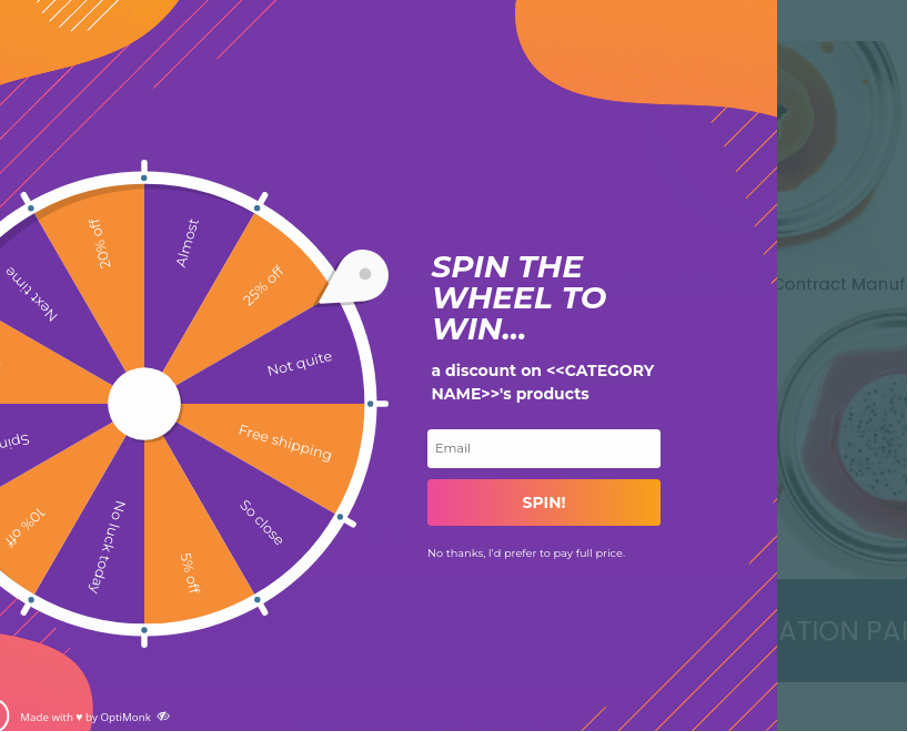
While this may seem like a small difference, the ecommerce conversion rate was 46% higher for the personalized campaign than for the one without any personalization!
4. Personalization for cross-selling/upselling
This ecommerce personalization example can help raise your average cart value by recommending products that naturally bundle together.
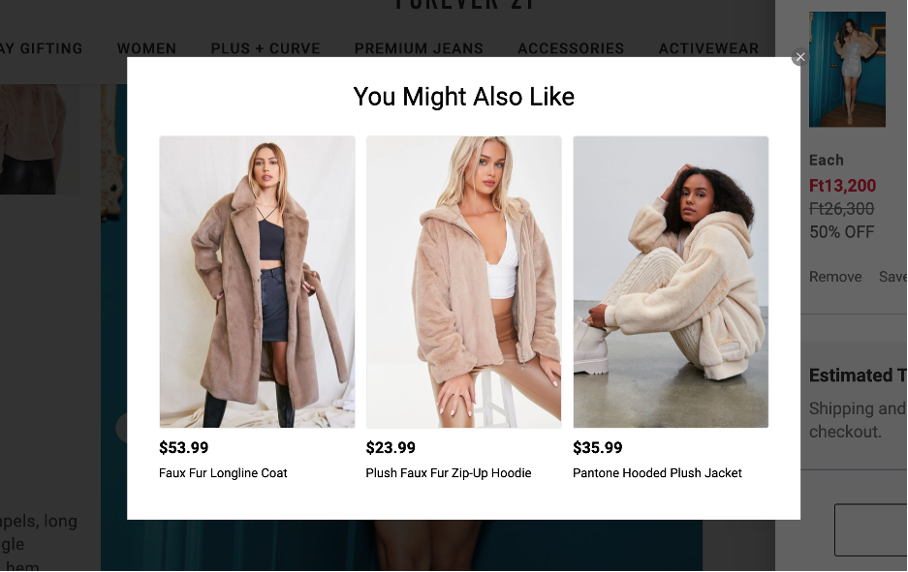
If you’d like to set up cross-selling and upselling recommendations yourself, OptiMonk’s intuitive system of targeting rules and cart rules (which create segments based on the items individuals have in their cart) allows you to do just that.
Check out this how-to article for creating your own recommendation rules.
5. Personalization based on country
One of the most popular ecommerce personalization tactics is showing country-specific shipping info based on where users are located.
Both your new and returning customers will appreciate having clear, accurate shipping information. No one likes the unpleasant surprise of discovering high shipping costs at checkout, so providing this information up front goes a long way toward creating a great user experience.
Here’s how Billabong collects data about their new customers’ locations:
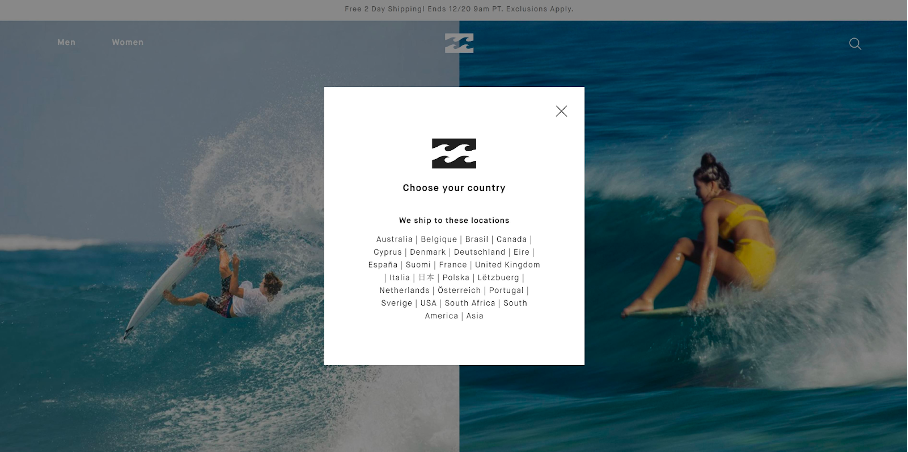
And here’s an ecommerce personalization example from an online store based in Hungary that uses dynamic content to change the country listed after the “We deliver here” copy.

6. Personalization based on cart value
If you have a free shipping threshold, you can use on-site messaging to inform customers exactly how much more they need to add to their cart in order to qualify.
Presenting this information in a sticky bar provides a constant reminder to customers that they can save on shipping by adding a few more items to their cart.
Since people love nothing more than free shipping, this is a great way to increase your site’s average cart value and keep your customers happy.
Here’s an ecommerce personalization example of what a dynamic free shipping bar can look like from BLK & Bold:

Once users have enough in their cart to qualify for free shipping, the sticky bar updates to show the following message:

And finally, here are some OptiMonk templates you can use to set one up on your own site:
7. Personalization based on traffic source
Another popular way of personalizing the ecommerce experience is by reflecting the traffic source of your visitors in the webpage content. This is often easy to do because most ecommerce personalization platforms give you access to your traffic sources.
Here are two ecommerce personalization examples of tailored messages for traffic arriving from Instagram and Facebook.
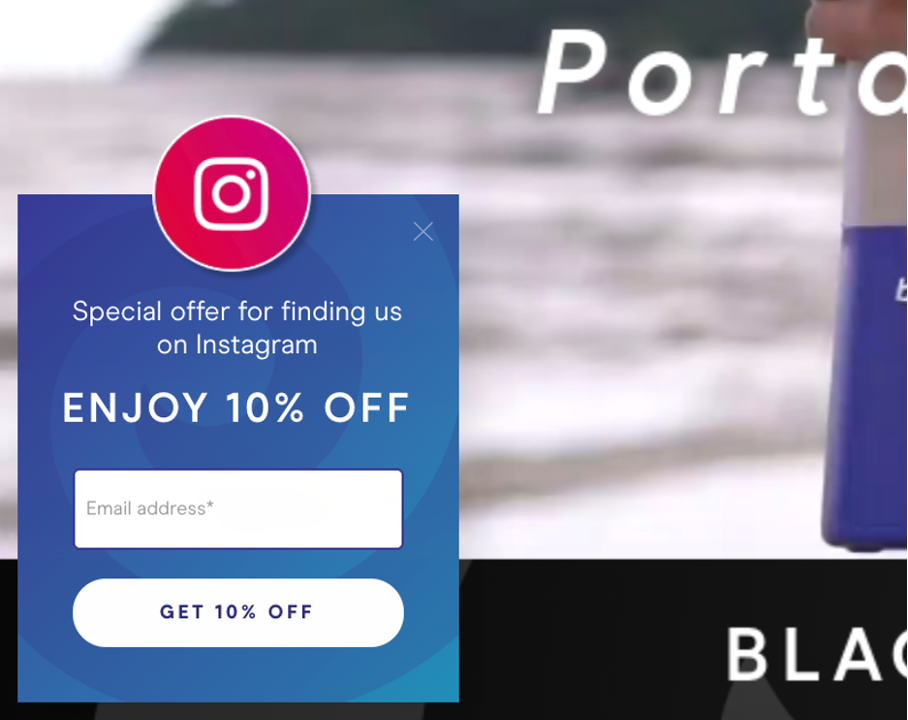
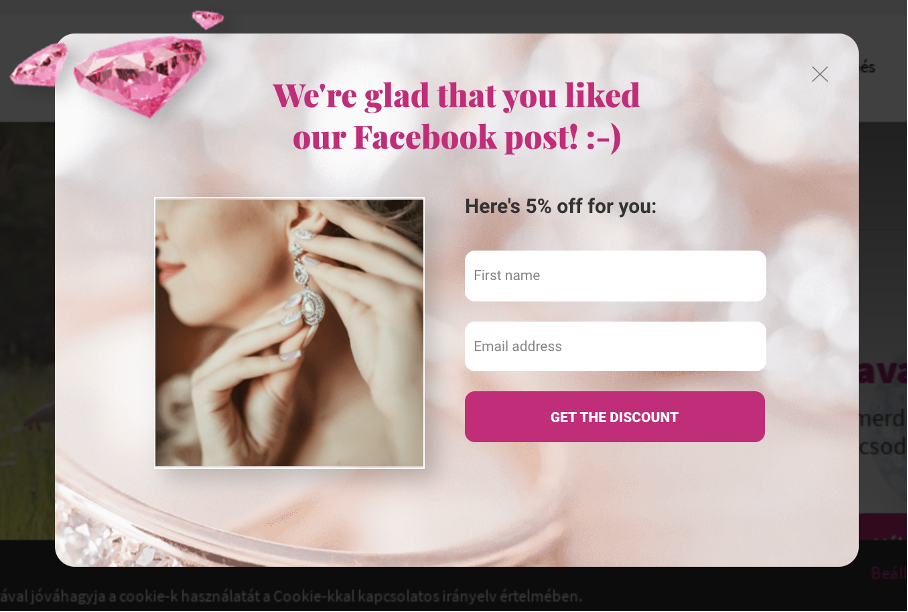
For more ideas on how to personalize your ecommerce store, watch this 6-min video:
Recommended reading: 13 Website Personalization Examples That Are Guaranteed to Boost Your Results
The 4 best ecommerce personalization software for your online store
Most ecommerce platforms, such as Shopify, HubSpot, and WordPress, allow you to capture some first-party data and use third-party data.
This can really jumpstart your personalization, but you’ll need the right ecommerce personalization tools to analyze this data and put it to use.
So how do you find the best ecommerce personalization platform? Here’s a list of the 4 best options.
1. OptiMonk
Pricing: Free, or from $39/month
As we saw in a few of the examples above, popups are a great way of sending personalized messages to both new and returning customers. And OptiMonk’s advanced targeting features make it ideal for that very purpose.
Rather than trying to create a single one-size-fits-all popup, you can create a suite of popups that are optimized for different audiences.
For example, you could display certain popups to users who have added specific items to their cart. You could also show different popups to first-time and returning visitors. Or you could target visitors based on a specific landing page they’ve already visited.
You can also target customers based on:
- Location
- Traffic source
- Time spent on pages
- Time spent on site
- Cart rules
- Custom rules
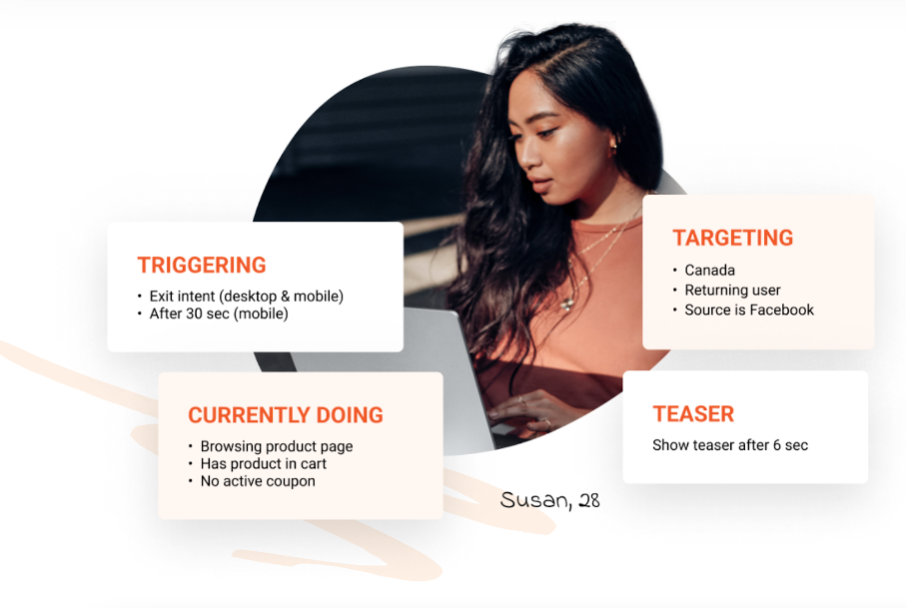
You can use the full range of targeting features on each of OptiMonk’s more than 300 popup templates.
The powerful drag and drop editor allows you to customize each campaign to match the look and feel of your store without writing a single line of code.
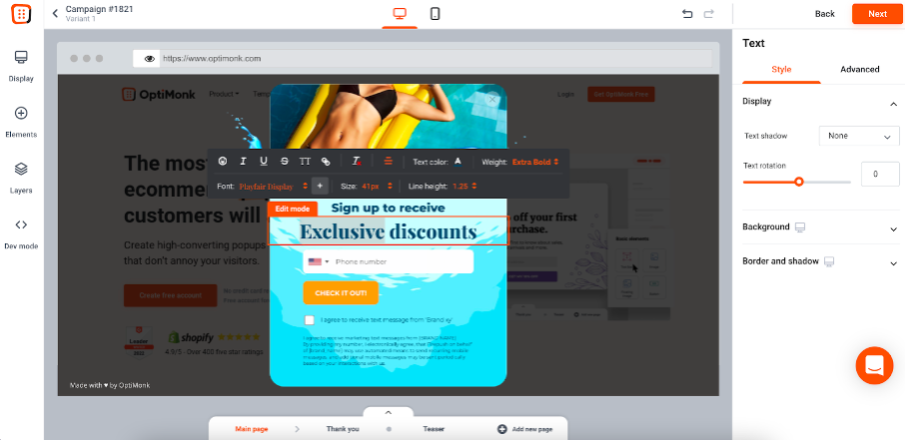
Finally, OptiMonk boasts a wide range of integrations that help ecommerce stores build a unified marketing strategy using several tools at once. You’ll notice our next ecommerce personalization software in the list below.

2. Klaviyo
Pricing: Free for up to 250 contacts, after that from $20/month
Klaviyo is an SMS and email marketing platform that allows you to send personalized texts and emails to your contact list.
Personalized emails are a great way of nurturing your relationship with your repeat customers and maximizing their lifetime value.
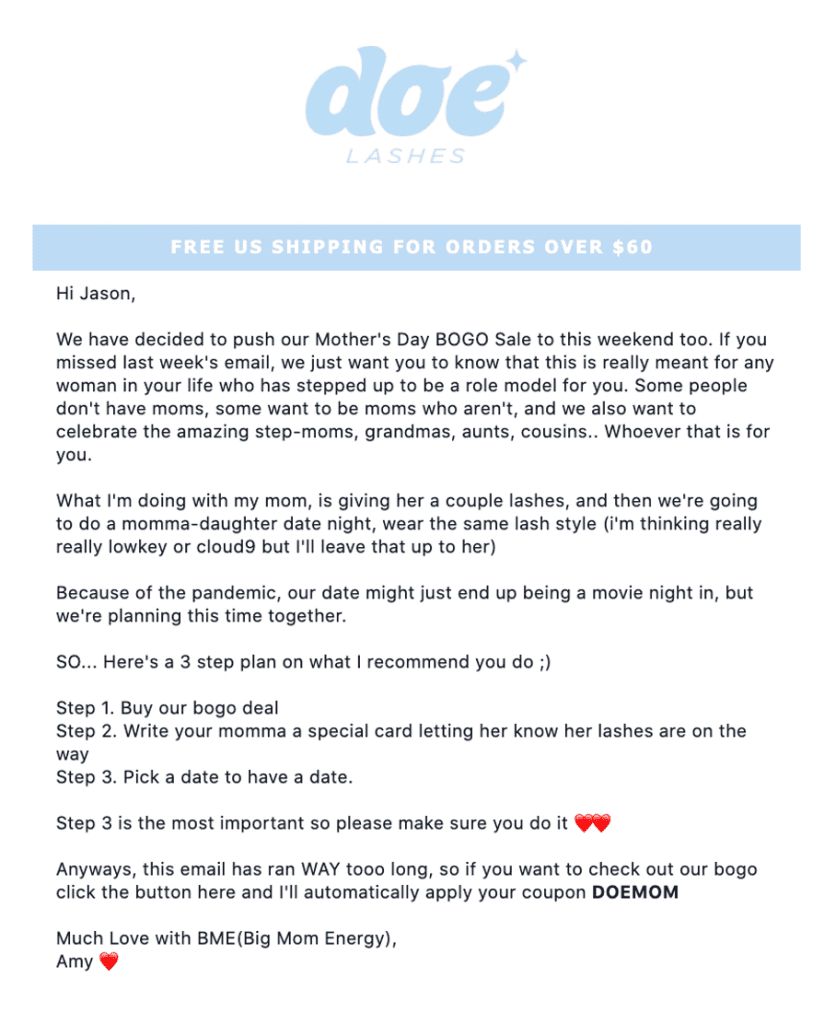
Like most email marketing software, you can personalize your emails using a customer’s name. But you have several other options with Klaviyo because the software builds a “profile” of each subscriber, filled with information you can use to personalize your emails.
That means you can also send emails with personalized product recommendations, unique coupon codes, and any other custom variables you come up with.
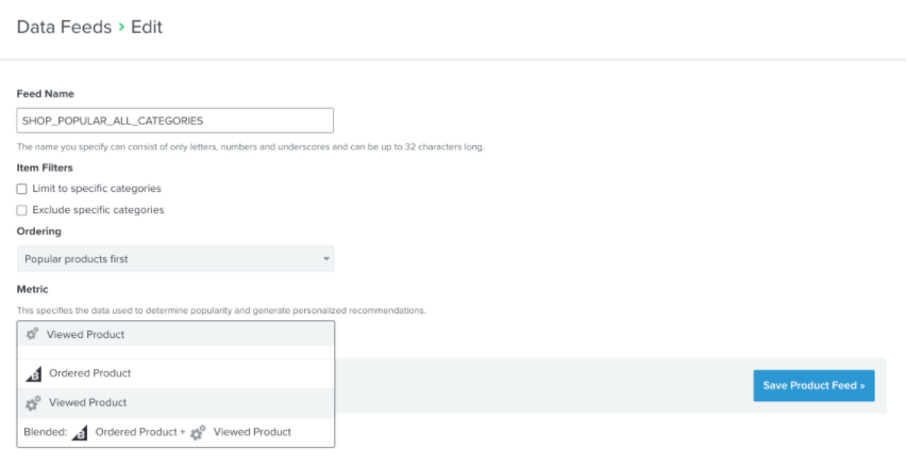
As we mentioned, Klaviyo integrates with OptiMonk, meaning that you can collect email addresses and phone numbers using personalized popups from OptiMonk, and then send personalized emails and texts using Klaviyo.
Check out this article for more details about how to collect data through OptiMonk popups to personalize your Klaviyo email & SMS flows.
3. Apptus
Pricing: Custom
Apptus is an ecommerce solutions company that provides several ways of personalizing the customer experience.
One of the most impactful ways of using Apptus is their personalized search feature.
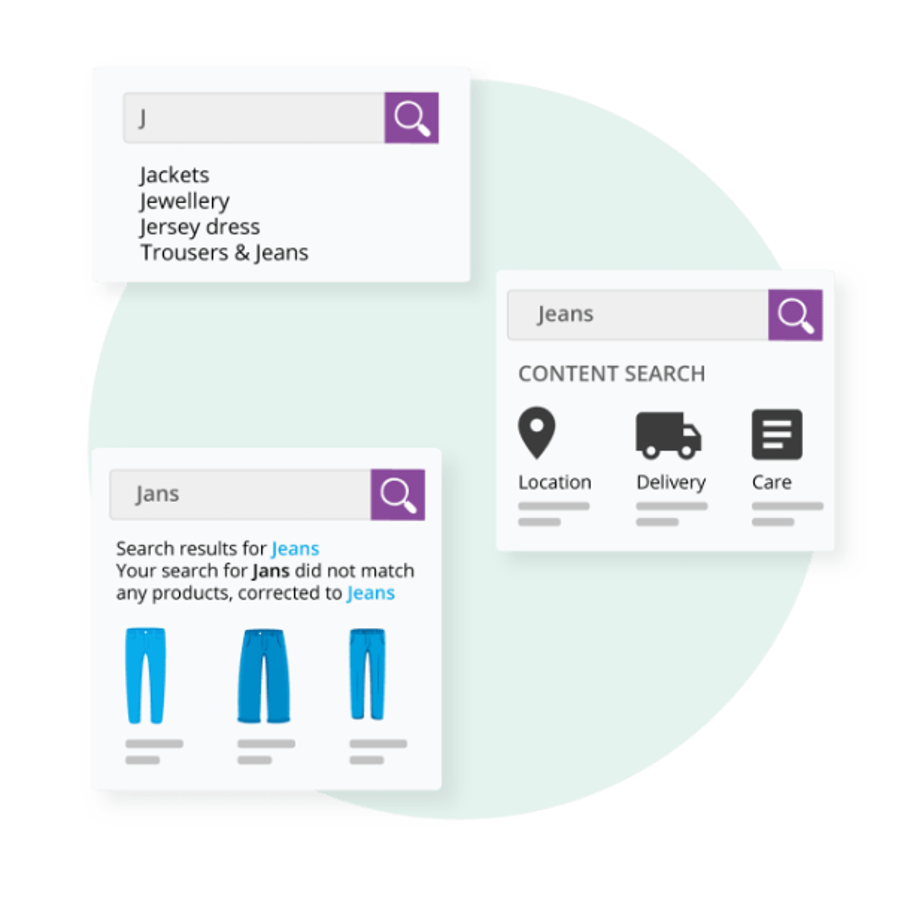
By auto-filling users’ searches and suggesting relevant products, Apptus can dramatically shorten the customer journey by getting users to the products they’re interested in quickly.
4. LimeSpot Personalizer
Pricing: $10/month to $400/month
Shop owners no longer need to guess which products to recommend. Instead, you can leverage data to make recommendations tailored to each customer’s preferences.
The LimeSpot Shopify plugin completely automates the process of collecting personalized data and making recommendations to visitors. You can display these customized recommendations on your homepage, cart page, or checkout page.
You’ll see an increase in average order value and sales when you show your customers products that align with their wants and needs.
Added bonus: Limespot’s Personalizer makes creating retargeting campaigns easier. Knowing the product categories potential customers are interested in makes your retargeting emails much more effective.
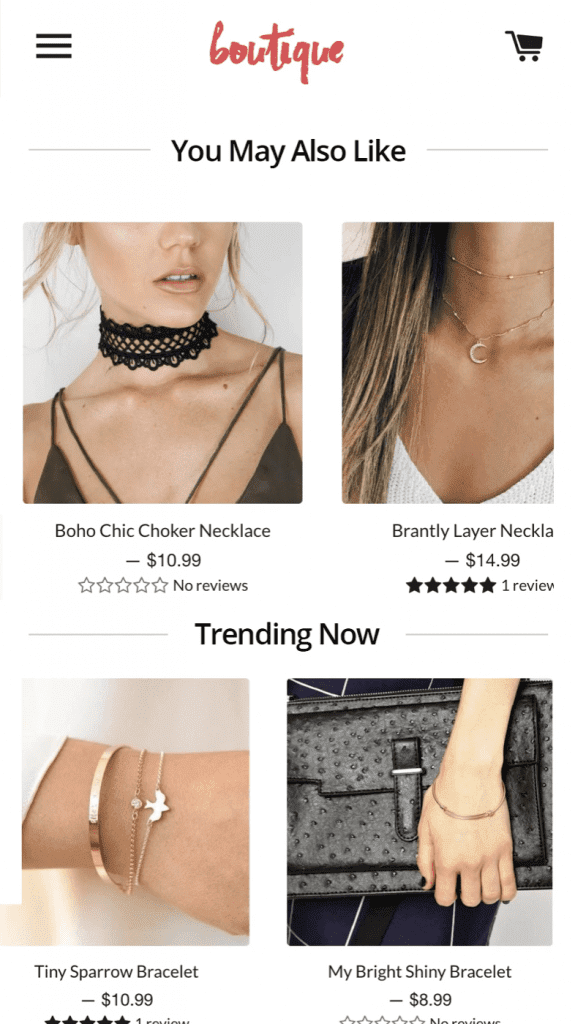
FAQ
What is ecommerce personalization?
Ecommerce personalization is a marketing strategy and technology-driven approach that allows online retailers to deliver personalized shopping experiences to their customers. This process involves collecting and analyzing data on shoppers’ behaviors, preferences, and interactions across various touchpoints of the ecommerce ecosystem. By leveraging this data, ecommerce sites can customize the content, product recommendations, offers, and messages to meet the individual needs and interests of each customer.
What are the benefits of ecommerce personalization?
Personalization offers a multitude of benefits for ecommerce sites, including increased conversion rates, enhanced customer satisfaction and loyalty, higher average order value, and improved customer retention.
What are the 4 Rs of personalization?
The 4 Rs of personalization represent a framework that guides how an ecommerce business can approach personalization to effectively engage customers. These are:
- Relevance: Ensuring that the content, products, and offers presented to the customer are relevant to their interests, behaviors, and current context. This means showing items that align with their past interactions, preferences, or search history.
- Recency: Taking into account the most recent actions of the customer to provide timely and pertinent recommendations. This involves dynamically updating personalized content based on the latest interactions or changes in preferences.
- Recognition: Acknowledging the customer’s relationship with the brand by providing a consistent and personalized experience across all touchpoints. This includes remembering past purchases, preferences, and interactions to facilitate a seamless shopping journey.
- Reward: Offering personalized incentives, rewards, or exclusive deals that not only appreciate the customer’s loyalty but also encourage further engagement and purchases. This aspect of personalization helps in making the customer feel special and valued.
Implementing the 4 Rs effectively can help you create more meaningful connections with your customers, leading to improved satisfaction, loyalty, and ultimately, business success.
Recap
We hope you’ve found some value in this deep dive into ecommerce personalization. It’s already an incredibly important part of ecommerce and will only become more essential in the future.
It’s also quickly evolving as online retailers gain more and more capabilities for providing a personalized experience to their customers. You’ve got to stay on the cutting edge to avoid falling behind the pack.
If you’re ready to start personalizing your store today, we’d recommend setting up some personalized OptiMonk campaigns. It’s free and there are hundreds of ready-to-go templates that will raise your conversion rates—so if you haven’t already, create your account now!
Migration has never been easier
We made switching a no-brainer with our free, white-glove onboarding service so you can get started in the blink of an eye.

What should you do next?
Thanks for reading till the end. Here are 4 ways we can help you grow your business:
Boost conversions with proven use cases
Explore our Use Case Library, filled with actionable personalization examples and step-by-step guides to unlock your website's full potential. Check out Use Case Library
Create a free OptiMonk account
Create a free OptiMonk account and easily get started with popups and conversion rate optimization. Get OptiMonk free
Get advice from a CRO expert
Schedule a personalized discovery call with one of our experts to explore how OptiMonk can help you grow your business. Book a demo
Join our weekly newsletter
Real CRO insights & marketing tips. No fluff. Straight to your inbox. Subscribe now
Nikolett Lorincz
- Posted in
- Personalization
Partner with us
- © OptiMonk. All rights reserved!
- Terms of Use
- Privacy Policy
- Cookie Policy
Product updates: January Release 2025









